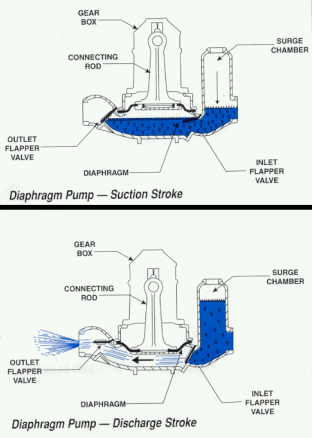|
Diaphragm pumps use a positive displacement design rather than centrifugal force to move water through the casing. This means that the pump will deliver a specific amount of flow per stroke, revolution or cycle. Engine powered versions are the most common and typically use the drive shaft to turn an offset connecting rod that is coupled to a flexible diaphragm. The connecting rod alternatively raises (expands) and lowers (contracts) the diaphragm at a rate of 60 cycles per minute (RPM). A vacuum is created inside the pump casing each time the diaphragm is raised (see figure below). This opens the inlet valve and seals the discharge valve allowing water and air to enter the pump. When the diaphragm is lowered the resulting pressure seals the inlet and opens the outlet valve purging the pump housing of water and air. Unlike centrifugal designs the water inside the casing is  Diaphragm pumps are commonly referred to as A diaphragm pump provides the lowest rate of discharge and head by comparison of any contractor grade pump. The most popular are 2 and 3 inch gasoline powered models producing flows in the range of 50 to 85 GPM. They have the ability to handle air without losing their prime and of handling water with a solid content greater than 25% by volume. Slow seepage applications are the most common uses for diaphragm pumps. These conditions exist in any trench or excavation where groundwater seeps slowly into the work site and in areas with high water tables. In these environments centrifugal pumps are unable to perform effectively because their high discharge volumes combined with low water levels would cause the pumps to quickly lose their prime. Another design benefit is that diaphragm pumps do not run the risk of being damaged if run for long periods of time. Since there is no impeller or volute the only wear parts are the flapper (inlet and outlet) vavles along with the diaphragm. |
